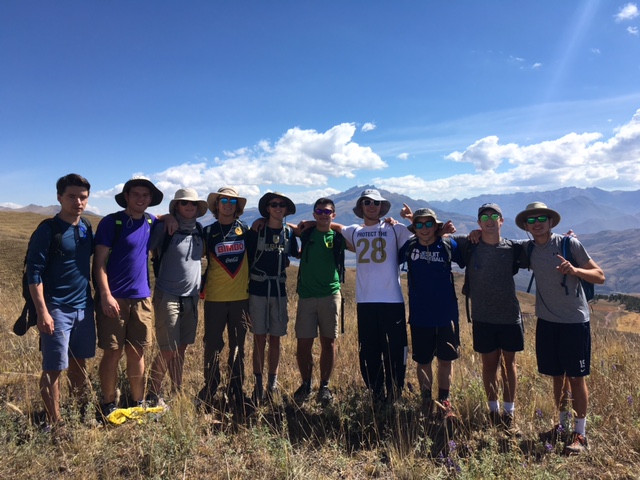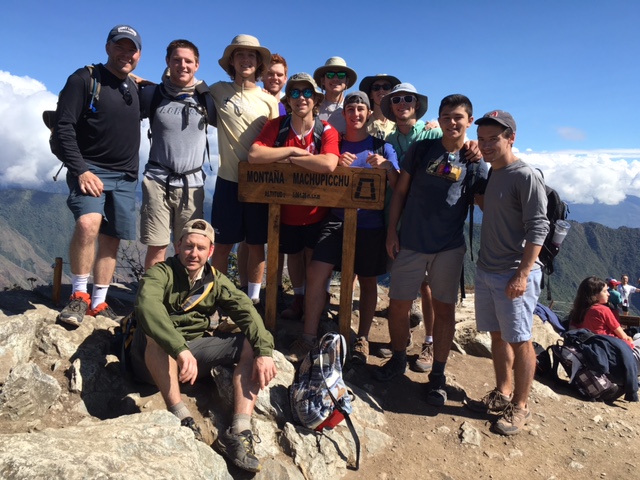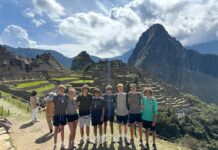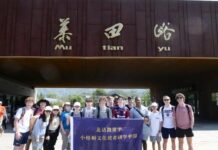Poverty terrorizes people and families in America. People struggle to provide food for children, make payments on a house, or simply keep running water in their systems. Poverty has become an increasingly prominent issue and affects people’s everyday lives.
However, despite the immense poverty in America, most countries suffer far more than we do. Regardless of our desire to help others, somehow the efforts made are never enough to overcome the selfish culture in America. In addition, these issues common in America are of a different magnitude than in other countries. In fact, some countries deal with poverty levels that make American levels look much better in comparison.
It is in this mindset that every summer Jesuit students are chosen to go on a trip each summer to a developing world country. In these countries the students strive to provide service, companionship, and the overall “Men for Others” ideal. Jesuit strives to provide people an opportunity to serve in another country and witness some incredible sights. That is the Jesuit mission, and this is exactly what a group of rising seniors did this summer in Peru.
This Summer from July 1st to July 11th, 9 rising senior students and 3 Jesuit faculty members travelled to the South American country of Peru for one of the many summer immersion trips Jesuit offers. The group consisted of Luke Przybylski, John Bowen, Alec Hanson, Will Gibbins, Thomas Nolan, Teddy Wagner, Sean Maguire, Paul Gramling, and Reid Hatzmann (myself) along with faculty members Michael Riemer, Ian Berry, and David Williams – all three Jesuit graduates.
During their stay, the students grew together as a group through daily interactions while also serving the kids of the local Jesuit parish, touring Macchu Picchu and the ancient ruins, and participating in nightly reflections regarding faith, the trip, and their lives back home.
The Trip itself was divided up into 2 portions: the first of which was spent in the rural community of Andahuaylillas, the site of a local Jesuit parish, and the second half was spent in the Cusco region where Macchu Picchu and the Inca ruins stand.
While each day’s layout varied, every evening the group gathered together for a time of prayer and reflection on a certain topic. These topics were faculty chosen but student led and included a large portion of time devoted to group sharing and discussion.

The first 5 days of the trip were spent at the Jesuit Church of San Pedro Apóstol De Andahuaylillas, also known as the “Sistine Chapel of the Americas.” This parish was the center of community activities during the week and it continually serves as a refuge to children who need food, comfort, or simply just some friends to play soccer. It was in this parish that the Jesuit students held most of their interactions with the Peruvian children.
While the Jesuit group was there, there was a nationwide teacher strike and school was cancelled because teachers couldn’t get to the schools due to blocked roads or their own participation in the strike. So, school was cancelled and the children had nowhere to go on these days. It was in this time that the Jesuit students created an opportunity for kids to come play in the parish by creating posters and posting them around the town for all the kids to see.
Each afternoon became recreation time for the people in the community. Whether it was arts and crafts or soccer games, the American travelers and the local kids, ranging from ages 4 to 12, interacted and formed some incredible bonds. The kids came each day and decided what they wanted to play while the Jesuit students joined in and strove to get to know them, despite the language barrier that some kids had to overcome.
While most students on the trip had taken some form of Spanish in high school, three of the students had only taken Latin and thus had a harder time communicating with the kids. However, the desire to interact and embrace the culture they were in transcended that language barrier and built some unique relationships.
The “joy with which the kids interacted with each other was inspiring and beautiful,” commented Luke Przybylski ’18. These afternoons with kids pushed him “to be grateful for the blessings we receive because we are so blessed in America.”
Outside of these afternoon interactions, the group partook in 2 significant events that marked this time together in Andahuaylillas. The first of which was the daily hikes. The first 2 hikes were relatively easy and had been done before by past groups. The second of these hikes was about a 30 minute endeavor to a plateau of about 20 yards where a cross, decorated with flowers, textiles, and other art, stood alone. It was at this resting ground that the group of students and faculty held one their first deep reflections. The topic that day was forgiveness and mercy and the mixture of reading, group sharing, and nature was truly remarkable. Przybylski noted that this reflection was “a deep moment where we seemed to gel as a group for the first time.”
The students completed their first major hike of the trip, summiting “Viva Anda” mountain that rests at about 12,500 feet elevation. The hike was about 4.5 hours round-trip and was an increase in 2,000 feet over the course of the hike. By far the most strenuous activity so far, the hike was an incredible opportunity for the group to bond and accomplish something truly awesome. For some students, this hike was a major highlight of the trip.
John Bowen ’18 remarked, “My favorite group memory was definitely hiking directly up the face of the mountain to the ‘Viva Anda’ letters and the chain of guys that we formed to push and pull each other up the steep parts.”
The second of the unique opportunities was the group faith formation sessions in the rural extremities of Andahuaylillas. In these rural outskirts, each night a group of 3 students and 1 teacher went with Alfredo, the community faith formation leader, to a small town to teach and play with the kids.
These nights usually started with a game of soccer and then transitioned into some light learning, finally concluding with games for the children. These evening sessions were incredible experiences for the guys and truly were a highlight of the trip because it gave yet another view of the innocence and purity of the people who lived there.
Bowen recalled these events as an individual highlight of his trip: “My favorite personal memory was when I arrived in the small town where I’d been doing the catechism class. A small boy, who I had never seen before and who had never seen me, ran up to me and hugged me. It was very random, but at the same time it was a really touching experience.”
The boys said goodbye to the friends they had made in Andahuaylillas as they transitioned into the second phase of the trip: Cusco, the Incan ruins. On their first day there, the group went and saw the first set of ancient ruins. They learned about terracing, Incan theology, and Incan infrastructure as they witnessed and navigated one of the Incan buildings. Although not Macchu Picchu, the ruins had a great deal of history and teaching in them as the guide linked everything about the site to some specific Incan purpose.
On the second full day in Cusco the group made their way up to Macchu Picchu. Initiated with a 5 am train ride, an hour waiting in line, and another 30 minutes on a bus taking switchbacks up the mountain, the group finally reached their destination. Inside Macchu Picchu, the group started with some information and a basic lay of the land while also marveling at the sheer beauty of the site. From preservation of ruins to the general splendor of nature, the ruins were a sight to see and something the boys will never forget.
Following this initial entrance, the group began the bulk of their day: the hike up Macchu Picchu. The hike was incredibly steep and took about 2.5 hours round-trip with many sections of the hike marked by narrow walkways and life-threatening drops. Along this “stairway to heaven” the group felt the altitude effects set in as breath became short and rest breaks felt even shorter. While this hike was shorter than the previous hikes, the steepness of this hike was unmatched.
Finally, the group made the top and marveled at the beauty of everything in sight: snow-covered peaks, mountains that protruded above the clouds, and of course, the aerial view of Macchu Picchu. It was on this peak that the group found a sense of fulfillment. For me, this was the culmination of the trip. Although so much happens when going to Peru, Macchu Picchu is the definite highlight-it’s not every day that you see a wonder of the world. Following this hike, the group received a tour of Macchu Picchu and learned all the uses of the historic buildings and tools.
Thomas Nolan ’18 recalled, “One of the coolest aspects of Macchu Picchu was their ability to use sundial systems to tell certain dates of the year.”

The final aspect of the trip was the 10 nightly reflections. The group had 9 student members and 3 faculty members. Thus, each day was led by a student and then the final day was led by the three teachers. These reflections conquered a span of topics from simplicity to faith to encountering people and being present to them. Each night started with a scripture passage, a secondary faith reading, and then a reflection by that night’s leader.
Following all of this, the group moved on to the discussion questions where students began to look deeper into their lives, actions, and relationships with Christ and others. These discussions oftentimes went deeper than most would imagine and quickly became a favorite daily event for the group. Bowen noted that these nights were “incredibly special,” and they helped him realize, “oftentimes on these trips, the people going to serve end up receiving more than the people they serve.”
Mr. Williams, one of the faculty members on the trip with prior trip experiences, noted that the groups reflections played a major role in the success of the trip: “This group was fun and enjoyed a good laugh but as soon as we began talking reflecting about our day it was like someone flipped a switch. All of these thoughts and observations from the day rolled out into the table and these 17 year olds kids were processing this new world with mature and empathetic minds. Each night that we prayed and talked together was an edifying moment for me.”
As these two indicate, the nightly reflections added an aspect of the trip that helped foster the unity of the group and ultimately make it an experience that lasts longer than a single week.
Ultimately this trip was meant to be a formative experience for students, but on the trip the students also were exposed to so much more: a different culture, a different economic status, and a different way of experiencing life. The trip served for many as a recognition of the gifts and blessings we have. Along with that, the group also recognized the responsibility to serve and help others who may not be as fortunate as the Jesuit students.
Przybylski summed up the trip perfectly when he described his overall review of the trip, “The journey was amazing and we made memories that none of us will ever forget. However, if all we took from this trip was personal mementos, then we are missing something. Above all our personal memories, we recognized a call to serve God’s people in America and over the world. It’s the way Christ lived, and it’s the way Jesuit teaches us to live. This trip simply served as a reminder and a nudge in the right direction to do what we were called to do: serve others in the ultimate service of God.”






